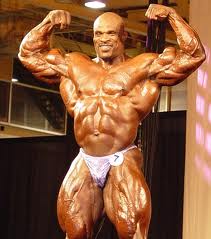
March 29, 2014
The Best Muscle Building Workout!?
Admit it. You’ve probably been lured into reading a magazine article with headline such as the one above. These types of claims are the norm rather than the exception in the muscle rags and fitness websites. And for good reason: the promise of a holy grail of workouts that will maximize your muscle development is an enticing prospect to say the least.
Problem is, no such routine exists.

It’s essential to realize that the response to resistance exercise is highly individual. Remember that research simply reports the means (i.e. averages). So if a study reports muscular growth after a given protocol as say 10%, you can bank on the fact that some subjects grew a lot more and some a lot less than 10%. Thus, you can’t simply extrapolate that you, or a client of yours, will achieve similar results to the reported mean.
Nowhere is this better illustrated than in a recent cluster analysis study by Bamman et al.. Sixty-six men and women performed supervised lower body exercise (squats, leg presses, and leg extensions) 3 days a week for 16 weeks. Training was carried out in typical bodybuilding-type fashion that included 3 sets of 8-12 reps for each exercise. At the end of the study, subjects were grouped by their hypertrophic response: The top 17 subjects were considered extreme responders. Their muscular gains averaged ~58%. Pretty awesome, right? The middle 32 subjects were considered moderate responders, with muscular gains averaging ~28%. Still pretty good, although well below the extreme responders. Here’s the kicker: the bottom 17 subjects saw, get this, NO significant gains after 16 weeks or consistent training. Zilch! Again, all subjects performed the exact same program but, as noted, saw widely disparate results. Based on the research, genetic factors are highly responsible for these differences, including the expression of various proteins (such as IGF-1) as well as satellite cell population. Lifestyle factors undoubtedly play a role as well.
Now the fact that people respond differently doesn’t discount that there are certain principles that should be inherent in any routine designed to maximize muscle-building. These include:
• Vary the loading strategies: Using different rep ranges (i.e. heavy, moderate and light) will ensure that you stimulate the full spectrum of muscle fiber types in a fashion that produces maximal growth. Recent work from my lab shows that light loads are suboptimal for fully activating the highest threshold motor units, but they may be superior for targeting the type I (endurance-related) fibers.
• Train with high volumes: There is compelling evidence that a dose-response relationship exists between volume and hypertrophy. Although a single set to failure can produce substantial increases in muscle growth, multiple sets are needed for maximal gains.
• Perform a variety of exercises: Muscles frequently have varying attachments and individual fibers are often compartmentalized so that they are innervated by different nerves. Research shows that a single exercise is not sufficient for maximizing whole muscle growth. To ensure complete muscle development, you need to have sufficient variety of exercise selection that takes into account basic applied kinesiological principles as outlined in my recent T-Nation article.
• Employ some sort of periodization scheme: This simply means that you need to manipulate variables over time. In particular, volume and training frequency should be varied over the course of training to prevent plateau. Ideally, volume/frequency should culminate with a relatively short training cycle designed to produce functional overreaching followed immediately by a period of deloading/active recovery. This will help promote a supercompensatory response that maximizes muscular gains. The process doesn’t have to be complicated; there are endless ways to go about periodizing a routine as long as you proceed in a logical fashion.
Given these basic tenets, it is essential that you take individual differences into account when designing training programs. There are no cookie-cutter prescriptions for getting big. For those familiar with my book, The M.A.X. Muscle Plan, you’ll know that I reinforce this concept repeatedly throughout the text. That’s why I refer to the book as a “template” for success; optimal benefits can only be achieved by customizing the program to your own personal needs and abilities.
Bottom line: There is no “best” muscle-building program; only a best program for a given individual.
6 Comments
RSS feed for comments on this post.
Sorry, the comment form is closed at this time.





 Entries (RSS)
Entries (RSS)




Stellar article Brad. Short and to the point. Great reporting on the paper by Bamman et al.
Super like +1
Comment by Etienne Juneau — March 29, 2014 @ 4:15 pm
Appreciate the sentiments Etienne 🙂 Cheers!
Brad
Comment by Brad — March 29, 2014 @ 4:40 pm
There is no best way for everyone; so true! Individual variation demands trial and
error in muscle building and strength training attempts. Great points Brad.
Comment by Keats Snideman — March 30, 2014 @ 10:07 am
Well Brad I even emailed my list about your book. Cheers!
Comment by Etienne Juneau — March 31, 2014 @ 3:20 pm
In your max plan you give nutritional guidelines for gaining muslce. Are we supposed to have a surplus of calories during the endurance and strength phases? Wouldn’t that lead to fat gain during the 15-20 and 1-5 rep phases because the 6-12 rep phases is the one that stimulates muscle growth?
Comment by Riley Gasmen — April 2, 2014 @ 10:36 am
Hi Riley:
You apparently misunderstood my comments here. Both the strength and metabolic phases of the M.A.X. Muscle Plan will certainly promote increases in muscle mass. It’s just that the extent of muscle growth will not be as great as with the hypertrophy phase. If you want to maximize the amount of muscle you gain, then you need to be in a slight caloric surplus.
Cheers!
Brad
Comment by Brad — April 3, 2014 @ 7:29 pm